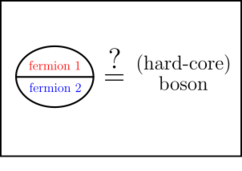Exclusion Principle for Hard-core Bosons
Several of the most fascinating particles found and described in modern physics are impenetrable bosons. Prime examples are liquid Helium, ultracold atoms and molecules and composite bosons (cobosons). The common feature of impenetrability, i.e. not being able to multiply occupy the same point in space/lattice site, has two possible origins which could not be more different: For liquid Helium and ultra-cold atoms it emerges from the repulsive pair interacting while for cobosons it is just the Pauli exclusion principle applying to their fermionic constituents.
 It is one of our ambitions to develop a unifying theoretical perspective on impenetrable bosons with the ultimate goal of understanding comprehensively emerging features. For instance, in [1] we have shown that the hard-core constraint imposes an upper bound on the maximal possible degree of Bose-Einstein condensation: For any system of N hard-core bosons on d lattice sites, occupation numbers are always bounded by N/d (d-N+1). In complete analogy to Pauli’s exclusion principle for fermions, this bound is universal in the sense that it is valid in any spatial dimensionality, for any lattice type and for any underlying Hamiltonian.
It is one of our ambitions to develop a unifying theoretical perspective on impenetrable bosons with the ultimate goal of understanding comprehensively emerging features. For instance, in [1] we have shown that the hard-core constraint imposes an upper bound on the maximal possible degree of Bose-Einstein condensation: For any system of N hard-core bosons on d lattice sites, occupation numbers are always bounded by N/d (d-N+1). In complete analogy to Pauli’s exclusion principle for fermions, this bound is universal in the sense that it is valid in any spatial dimensionality, for any lattice type and for any underlying Hamiltonian.
Clearly, the Pauli exclusion principle for the fermionic constituents will lead to qualitatively similar bounds on the degree of BEC of cobosons. Yet, there is one remarkable difference: The degree of internal entanglement between the constituents will affect the impenetrable character. It is the role of exactly this additional feature which we would like to elaborate on as well. For instance, we are wondering how the degree of BEC in systems of ultracold atoms [2] and molecules is affected by the internal entanglement. May we even control the transport properties of ultracold atoms from outside by changing the internal entanglement by coupling the atom gas to a light field?
[1] F.Tennie, V.Vedral, C.Schilling, Phys. Rev. B 96, 064502 (2017) [2] M.Máté, Ö.Legeza, R.Schilling, M.Yousif, C.Schilling, arXiv:2002.09997 (2020)

